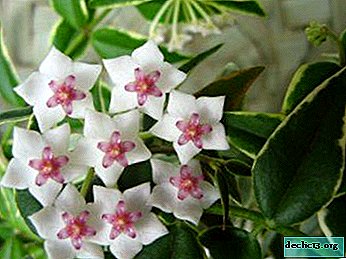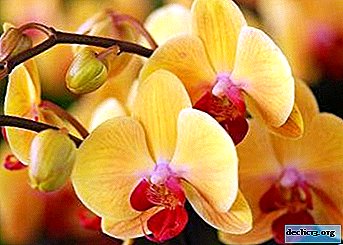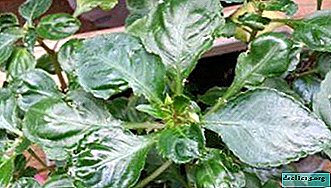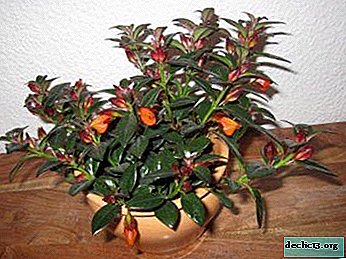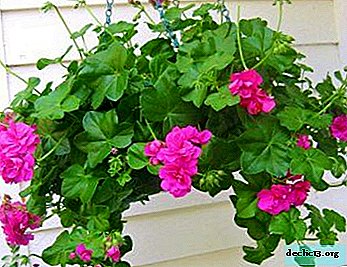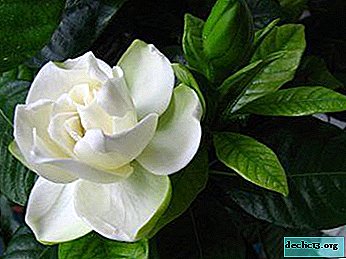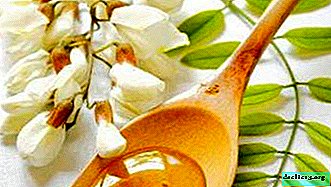Nobleness and grace of a rose Princess Anna: description and photo of the variety, flowering and care, reproduction and other nuances
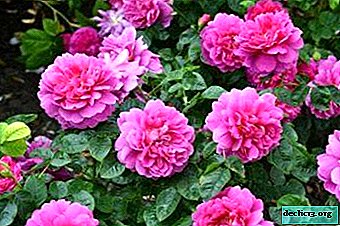
Rosa Princess Anna combines the nobility of English roses, the elegance of forms and the original flowering palette.
The plant is unpretentious and practically not susceptible to disease. However, in order to enjoy the beauty and aroma of flowering bushes, you must properly take care of their wards.
From the article you will learn what kind of variety it is, how to take care of it and care for it, as well as propagate, fight against diseases and pests, you will see a photo of a beautiful rose.
Grade description
Princess Anne - an English rose belonging to the class of scrubs. The bush is erect, dense, branched, in adulthood reaches a height of 60-120 cm and a width of 40-90 cm. Shoots are strong, almost do not wilt, densely covered with glossy dark green leaves of medium size. There are many thorns on the stems.
Large, densely-spread flowers with a diameter of 8-9 cm are collected in large brushes that are located throughout the bush. On one branch there can be from 3 to 5 flowers.
Freshly opened buds have a rich raspberry color. In full dissolution, the flowers are bright pink. Petals are narrow and dense, have a yellow undertone from the inside. In one flower, there are up to 85 petals.
The aroma of tea roses, medium saturation. Flowers well withstand short rains and, under favorable conditions, remain on the plant for 5-6 days.
The variety is highly resistant to powdery mildew and black spotting. The rose is practically not affected by garden pests. It is resistant to cold and needs winter shelter only in regions with very low temperatures.Pluses of roses:
- Excellent decorative properties.
- High level of resistance to cold and disease.
- Perfect for arranging bouquets. After cutting, they retain a decorative look and aroma for a long time.
- Suitable for growing on flower beds and flower beds, and for keeping in flowerpots and containers.
Minuses:
- Fades quickly on sandy soils.
- Under the scorching sun, the petals crumble.
Photo
Further on the photo you can see what the rose Princess Anna looks like.





History of occurrence
Hybrid bred in 2010 in the UK by breeder David Austin. The variety is named after the Princess of Great Britain Anna Elizabeth Alice Louise.
What is the difference from the rest of the species?
During flowering, two shades of flowers flaunt on the bush at the same time: pink and bright raspberry.
Bloom
- When and how? It blooms from June to the very frosts, continuously and abundantly. The variety refers to re-blooming roses.
- Care before and after flowering. Before flowering, potash and phosphorus fertilizers are added. Wilted flowers are removed in a timely manner.
- What to do if it does not bloom? If Princess Anne refuses to bloom, it is necessary to analyze the conditions of her maintenance and make adjustments. For timely flowering, a plant requires competent care:
- timely and correct pruning;
- full feeding;
- proper watering.
Use in landscape design
Compact branched bushes are ideal for growing in borders, and are also successfully used as fragrant hedges. Roses Princess Anna look attractive in single or group plantings on the background of the lawn, as well as in mixborders in composition with plants suitable for them.
 Choosing a companion for Princess Anne, you should give preference to plants with white, blue, blue, purple or pink flowers. Great fit:
Choosing a companion for Princess Anne, you should give preference to plants with white, blue, blue, purple or pink flowers. Great fit:
- phlox;
- veronica;
- catnip;
- delphinium;
- sage;
- bells;
- geranium;
- digitalis.
Step-by-step care instructions
Seat selection
Rose feels good both in the sun and in partial shade. You should choose well-lit areas that fall in partial shade at the very peak of solar activity. Adequate air circulation is welcome, but drafts and northerly winds are best avoided. Groundwater level should be below 1 meter.
Timing
For planting, it is recommended to choose the beginning of May, when the earth warms up well.
The soil
The plant prefers organic rich soils that allow air and moisture to pass through. The optimum acidity should be pH 6.0-6.5. Best of all, a rose feels on black soil. It is permissible to grow Princess Anne on loamy soil, but in this case, the soil must be enriched with organic matter.
Landing
 It is recommended to choose the seed planting method only if it is planned to obtain completely new plants that differ in quality from the parent ones. Variety properties are not preserved with this propagation method. To grow new instances of Princess Anne roses with the characteristic features of the variety, seedlings are used as planting material.
It is recommended to choose the seed planting method only if it is planned to obtain completely new plants that differ in quality from the parent ones. Variety properties are not preserved with this propagation method. To grow new instances of Princess Anne roses with the characteristic features of the variety, seedlings are used as planting material.
Their choice must be approached very seriously. Quality seedlings have a flat root neck, a multi-level root system and a well-developed above-ground part without dry elements. The young plant must be healthy in appearance, without damage and rot. It is better to buy planting material at the end of March or in April.
Before planting, the seedlings are kept in water for 4-6 hours. If the seedlings have an open root system, a growth stimulant is added to the water. Before planting, seedlings are kept in a cool place.
Landing Sequence:
- Dig a hole about 70 cm deep in the area.
- At the bottom, place a layer of drainage 10 cm high. You can use small pebbles, large gravel.
- Lay compost or rotted manure with the next layer. Layer thickness 10 cm.
- Top up garden soil.
- Make a hole.
- Lower the roots of the rose for a few minutes in a talker prepared from water and clay soil.
- Spread the roots and place in the hole. The root neck should be 3 cm below the surface.
- Fill the roots with soil, slightly compact the soil. After compaction, the root collar should be located below the surface of the earth.
- Pour the seedling under the root. Add earth if necessary.
- Mulch the soil around the rose with peat.
Temperature
The minimum winter temperature is -23 ° C. The optimum temperature in the warm season is +20 ° C. In extreme heat, especially in the sun, rose petals show off very quickly.
Watering
 Watering is done as the topsoil dries. In dry times, irrigation of the soil is carried out more often. The procedure is best done in the early morning. Use warm water.
Watering is done as the topsoil dries. In dry times, irrigation of the soil is carried out more often. The procedure is best done in the early morning. Use warm water.
It is necessary to protect flowers and buds from moisture and make sure that the stream of water does not erode the soil at the root system.
After watering, it is advisable to make shallow loosening of the soil, which improves the flow of air to the roots.
Top dressing
Feeding is carried out twice a season. In the spring make nitrogen. In summer, before flowering, they feed phosphorus and potassium. In July, fertilizer application is completed.
Weeding
It is necessary to monitor the cleanliness of plantings and regularly remove weeds. To reduce the frequency of weeding, the soil can be covered with sawdust.
Pruning
Sanitary and preventive
To maintain the health of the bush, it is necessary to carry out sanitary pruning - remove diseased, weakened and old shoots. In the spring, after removing the shelter, the old and non-overwintered branches are cut, and the young are shortened. In the fall, overgrown bushes and affected shoots are cut.
Formative
Features of the forming crop depend on the desired plant shape.:
- voluminous spreading bush - pruning 1/3 of the shoots;
- a bush with arched hanging shoots - 1/5;
- bush with erect shoots - 1/3;
- bush with long erect shoots - ½.
When grown in a mixborder, you can leave shoots with a height of 15 cm.
Important! To stimulate repeated flowering, it is necessary to remove faded buds in a timely manner.In the first year of life, a young rose is pruned so that it does not bloom.
Transfer
Princess Anne's roots go deep into the groundtherefore, after the transplant, the plant recovers for a long time. It is recommended to plant the rose immediately in a permanent place. If necessary, the plant is transplanted by transshipment. Adults over 6 years old are not recommended to transplant.
Preparation for winter
 The need for winter shelter exists only in areas with very low winter temperatures or changeable weather.
The need for winter shelter exists only in areas with very low winter temperatures or changeable weather.
In such climatic conditions, it is necessary to prepare everything necessary in advance in order to preserve such an amazing variety of roses on the site.
When steady colds occur, the bushes are spudled with earth and covered with spruce branches.. Over plants, wire frames are constructed above the bushes by 20-30 cm.
A heater is placed on the frame, a plastic film is pulled on top.
Breeding
To preserve varietal characteristics, roses are propagated vegetatively. The best way - cuttings. Cuttings are taken from healthy bushes after the first wave of flowering - from the beginning of July.
- Semi-lignified shoots are cut with secateurs. To do this, an inclined cut is made above a kidney located on the outside of the crown. Cuttings are cut from the lower and middle parts of the shoot, leaving one leaf at the top of the internode cuttings.
- The resulting planting material can be treated with a root growth stimulator.
- Prepare a plastic container with a lid and soil.
- Cuttings are planted in a container to a depth of 2.5-3 cm, observing an interval of 5 cm.
- Seal and moisturize the earth.
- The container is covered with a lid.
- They hold the container at high humidity and a temperature of approximately +20 ° C. Spraying regularly with warm water.
- The roots appear after about 30 days.
The next method of reproduction is dividing the bush:
- Dig up a bush in early spring.
- With a sharp knife, divide the bush into parts.
- Trim damaged roots and remove excess branches on seedlings. Each new plant should have 2-5 shoots. Shorten the shoots to 3-4 buds.
- Make a talker: mix clay and cow dung in equal parts.
- To process the root system of seedlings with the mixture.
- Plant bushes on the site. The upper kidneys should be directed outward or sideways.
Diseases and Pests
Most gardeners note that Princess Anne - a very healthy rose. It has a high resistance to diseases and pests and practically does not get sick.
Princess Novice is able to cope even with a beginner. The main thing is to responsibly approach the planting procedure, to prevent waterlogging and desiccation of the soil, to feed and cut the bush on time. The rose will respond to care with regular and long flowering.


